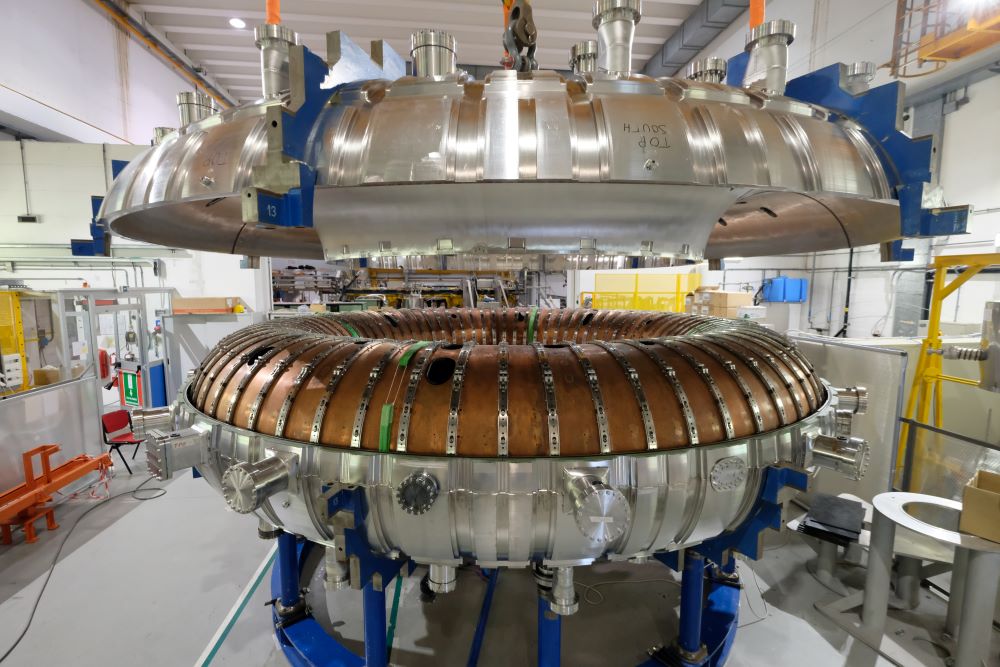the innovation behind the project
RFX-mod2 (Reversed Field eXperiment)
originates from the results obtained by the RFX-mod
device that was in operation until 2016.
The experiment aims to study the physics of fusion plasmas and magnetic confinement in Reversed Field Pinch (RFP) configuration.
The challenge of this new machine is to be able to produce a plasma with much improved parameters compared to those of RFX-mod and to clarify whether the RFP configuration can represent a valid alternative to the tokamak design in the perspective of a future fusion reactor.
The pinch configuration refers to a type of plasma confinement in which a plasma column is confined within a linear magnetic field. In this configuration, the magnetic field is strongest at the center of the column and weaker at the edges.

Plasma is a very hot gas, brought to temperatures high enough that strip electrons from the gas atoms (usually Hydrogen or Deuterium atoms are used). The atoms that have lost electrons become ions, i.e. electrically charged atoms. Plasma is therefore a hot, rarefied and electrically charged gas that lends itself well to being confined by magnetic fields.
RFX-mod2 is a toroidal machine, i.e. in the shape of a doughnut, which uses the magnetic field to confine the plasma using the Reversed Field Pinch configuration, an alternative to the Tokamak, based on magnetic fields of lower intensity and only using the ohmic effect for heating the plasma.
RFX-mod2 originates from the results of RFX-mod, the RFP experiment in operation until 2016, when the design of its upgrades started.
The RFX-mod2 machine is designed to complete and enhance the study of the properties of both the RFP configuration in the plasma current regimes up to 2MA and a variety of Tokamak equilibria.
To this end, modifications of some components of the RFX-mod machine are underway.
In RFX-mod2, the vacuum chamber will be removed, and the plasma will be directly surrounded by the copper shell (protected by 2016 graphite tiles). This increase in the conductivity of the first conductive material surrounding the plasma will allow us to observe plasmas without stationary localized interaction, even at high current regimes.

RFX is a device included among the High Priority R&D Infrastructures in the National Research Program 2021-2027 in the Energy sector.
The upgrades were financed by the Veneto Region under the 2014 – 2020 Por/Fesr research grants. The MIAIVO project, obtained in collaboration with the Industrial District of the upper Vicenza area, has brought in 2 million Euros of funding for research and development, slightly less than the half of the expected expense for completing all the upgrades.
RFX-mod2 have also obtained funds within the PNRR Nefertari Project of which CNR-ISTP is the proposer, along with the University of Padova and the University of Naples Federico II. New diagnostic systems and renewed facilities, will significantly improve RFX-mod2’s capacity to explore the potential of the RFP configuration as an alternative to the Tokamak configuration and to contribute to specific aspects of Tokamaks.
PNRR NETERARI – discover more here
INSIGHTS
Unveiling the evolution: upgrades from RFX-mod to RFX-mod2
Behind the build: crafting the innovation of RFX-mod2
Exploring insights: the crucial role of diagnostics in RFX-mod2
Crafting the path forward: theory and simulation in RFX-mod2’s journey
Follow the progress of RFX-mod2
Read the ongoing upgrades to the RFX-mod2 and be part of the progress
Prove di tenuta del vuoto in corso
Raggiunta un’importante milestone: la chiusura della camera da vuoto di RFX-mod2
Le modifiche di RFX-mod2 iniziano a prendere forma
I sensori di RFX pronti per la produzione in serie